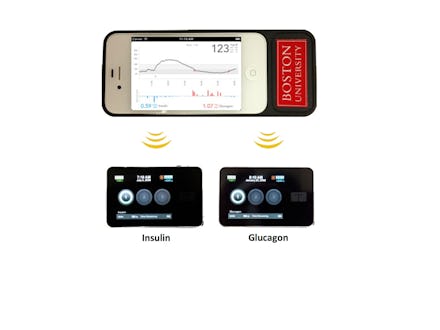A Father Has Invented a Bionic Organ to Save His Son From Type 1 Diabetes

Halfway to lifting a kernel of popcorn to your mouth, you pause. The couple you've been rooting for on the movie theater screen for the past hour is about to have their first kiss. The music fades. Silence adds to the anticipation. Then, out of nowhere, a violent beeping sound erupts from your seat.
If you live with type 1 diabetes, this is a familiar scenario. Your blood sugar has fallen dangerously low and the monitor you wear to keep it in check is telling you to eat something heavier than popcorn. Fast.
The fix: Boston University biomedical engineer Ed Damiano and a team of other researchers published a study earlier this month detailing a system that could prevent these dangerous situations. Inspired by his 11-year-old son David, who has type 1 diabetes, Damiano wanted a device that could automatically deal with the sudden dips and highs in blood sugar, which, if not treated quickly enough, can progress to confusion, numbness and even coma.
The device, which its creators are calling a bionic pancreas, delivers precise amounts of the hormones that a non-diabetic pancreas produces naturally to keep blood sugar levels steady. Despite its intimidating-sounding label, the bionic pancreas is relatively straightforward and worn outside the body.
Here's how it works:
A sensor implanted just beneath the skin keeps an eye on blood sugar levels and sends that information to an iPhone app. Every five minutes, the app determines how much insulin (which lowers blood sugar) or glucagon (which raises blood sugar) its wearer needs and sends a command to the device to deliver the hormones via one of two pumps.
Image Credit: AP
Although it's worn in a similar way, the artificial pancreas is different from an insulin pump in two key ways. First, an insulin pump only delivers insulin (not glucagon) into the blood. Second, people who wear insulin pumps must manually program them to dispense the proper amount of insulin by inputting the exact amount of carbohydrates they eat at each snack or mealtime.
In preliminary tests with 52 people, the bionic pancreas did a better job controlling blood sugar than the participants usually did on their own. The results of that trial were published in the New England Journal of Medicine. Damiano hopes his device will get approval from the Food and Drug Administration in time for David to use it before he goes off to college.
This is a game changer. Each year, about 20,000 people under age 20 are diagnosed with type 1 diabetes, which is characterized by episodes of high or low blood sugar. For non-diabetics, the pancreas monitors blood sugar levels and periodically releases hormones to keep it steady.
If you have type 1, your pancreas doesn't produce a sufficient amount, or any, insulin. You have to keep an eye on your blood sugar levels manually, usually with a painful finger prick and a quick blood test. If the test says your levels are too high, grab the insulin pump and prick your thigh. If levels are too low, go for a slice of bread or a piece of fruit.
Sounds a little complicated, doesn't it?
That's where the bionic pancreas comes in. Damiano hopes his son will one day have an iPhone app that takes care of all that work for him, allowing him to lead a more normal life. And based on his work so far, that day may come sooner rather than he later.